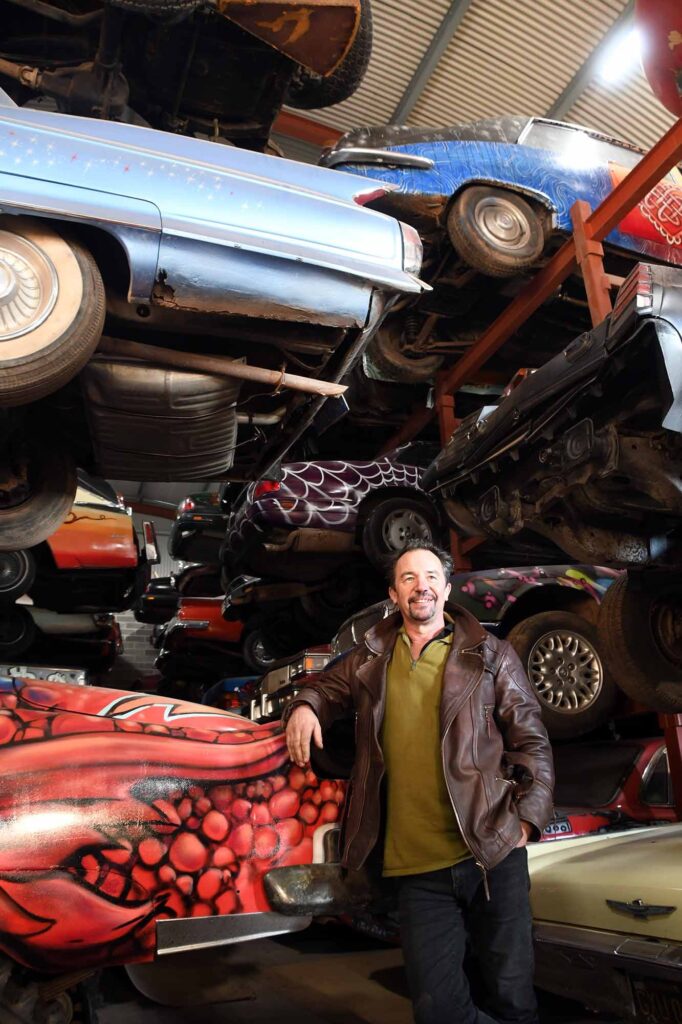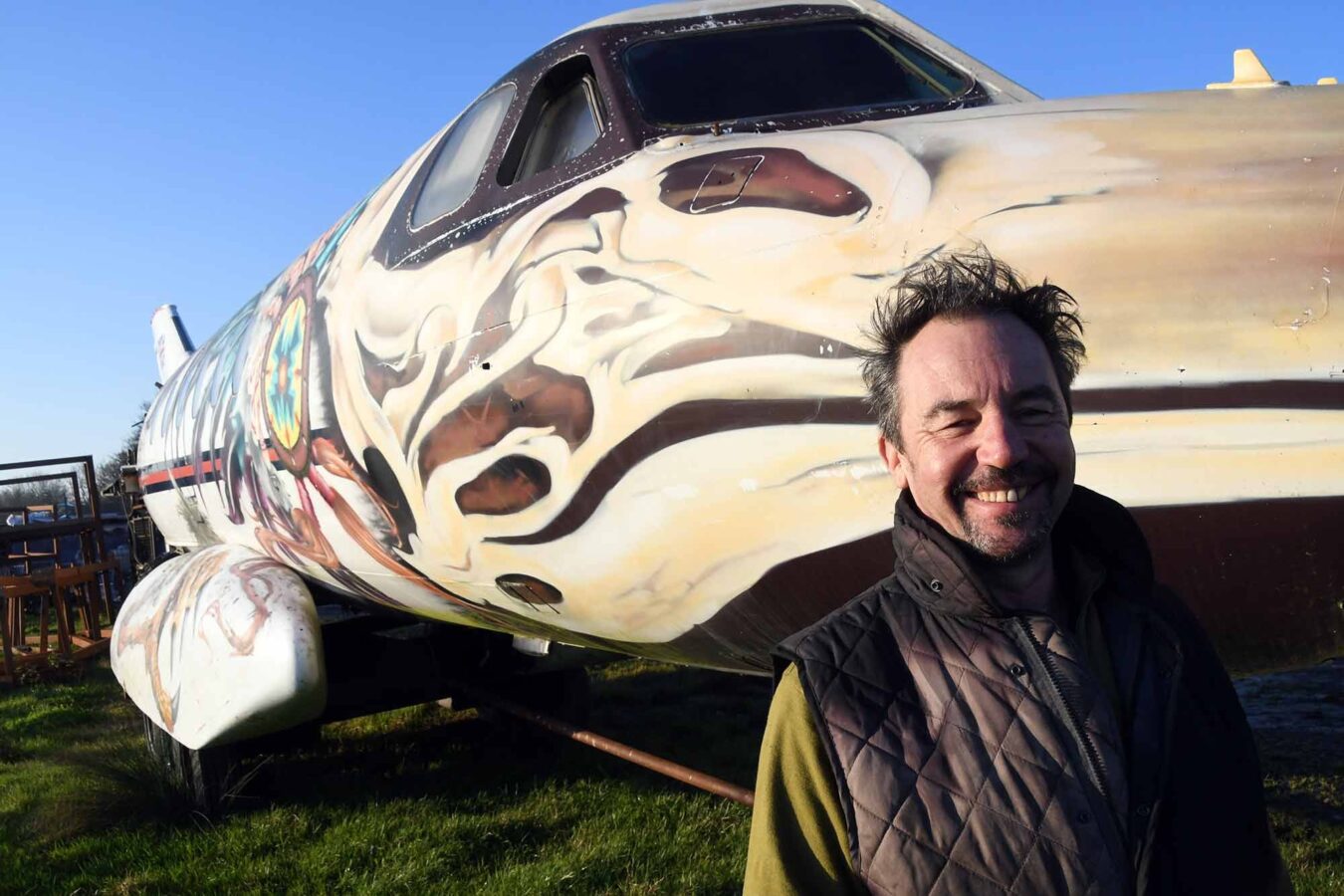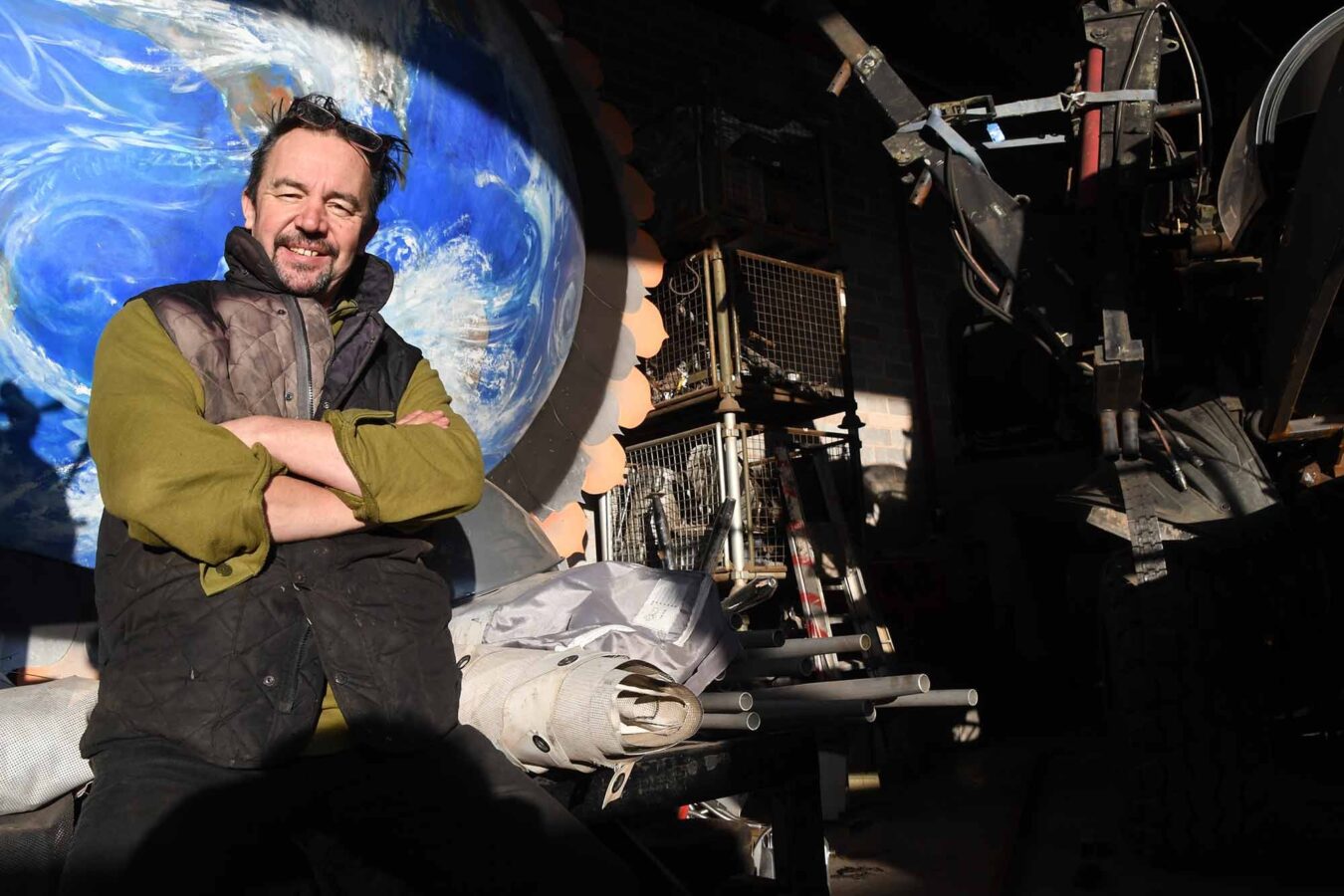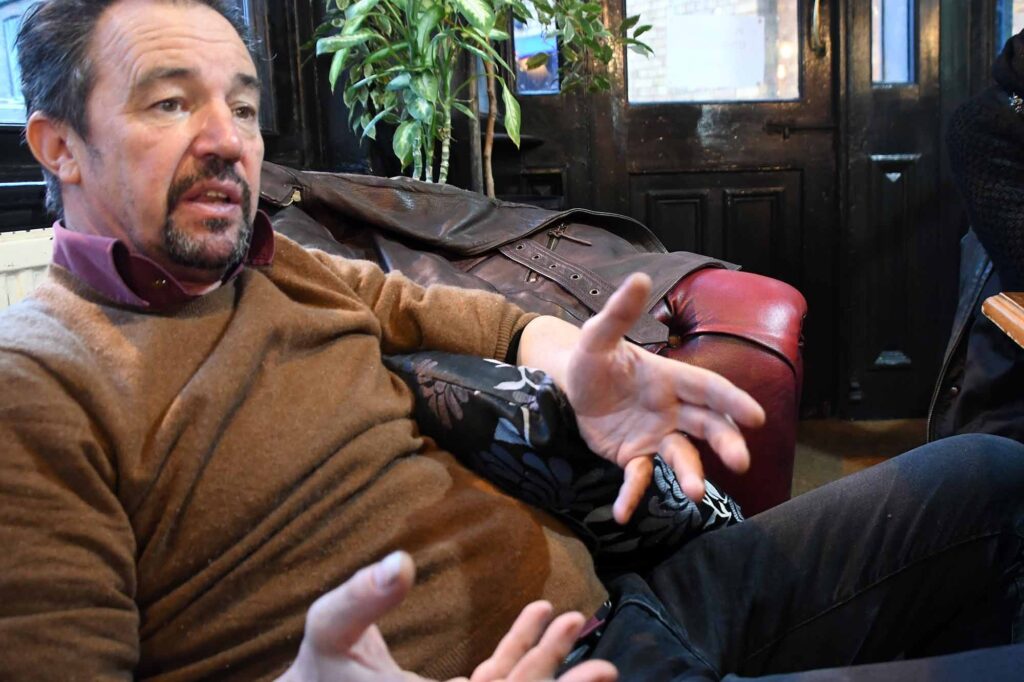Joe Rush’s ‘mutoid’ world and Fuji Rock
- 6月 17, 2025 ● Interviews

Every good festival has a legend, and whether it’s Joe Strummer in the parking lot or robots playing drum and bass, London artist Joe Rush has been at the center of it.
“I’d heard about Fuji Rock around 2002. Jason Mayall brought Fuji Rock producer, Masa Hidaka, and his partner, Shigemi, around the site. They came to the area where I was working called the Invisible Circus.”
According to Rush, when Masa sat down, he looked around, and there was my robot playing the drums, another robot dancing, and drum and bass coming out of the sound system. He just sat there and said, “This is what I want at Fuji.”
Rush said Masa looked around the whole site, but it wasn’t until he got to his area did he know that that was what he was looking for. Later, Rush began to develop a rough idea of what he wanted to do at Fuji, packing “bits and bobs” into a container, and then rushing off Glastonbury, to do the build on site.
“It was very tough because it was very hot and we didn’t have our tools. But in another way, it was very nice because we were treated very well and looked after, providing us anything we needed. It was quite nice to be respected the way we were.”
While the festival staff were supportive, the audience had a different take.
The reaction from the people of the festival: they’d never seen people work like us; they had no idea what we were trying to do. They couldn’t understand how we were using “gomi” and waste, how we were working with no drawings or calculations.

Rush described the crowd as very nervous, watching from a distance but too scared to come close.
There was also resistance from within the festival about the need to have art and the cost. But in the first year, a photograph of the giant ant was on the front page of one of the biggest-selling magazines in Japan.
This, as they say, broke the ice, and over the next two years, festival staff and the audience realized the importance of large-scale artwork at a festival.
“Resistance disappeared and turned into help. It’s normal; it happens in most places—people don’t understand you, so they resist you, and then they start to understand you and get behind it.”
He gives special credit to Masa for having the courage to support visual artists.
“Masa’s a visionary; he’s like Michael Eavis in that he understands you’ve got to keep doing new stuff and surprising people because people get bored very quickly and other festivals are coming up fast.”
He said bringing his group, Mutoid Waste Company, to the Palace of Wonder gave the festival a sense of anarchy. “It was a place you didn’t have to have a ticket; it was a place where anything could happen; it was a place for rookies.“
“Festivals can book bands for stages, but you have to give people something that is a life experience, and this is what Masa understood about Fuji.”
He said that different festival areas, such as theater, circus fields, meditation fields, and naughty late-night areas, provide something for everybody.
“It’s important the event equalizes people; the weather does it. Everybody’s suffering from the wet or the cold, and this bonds people; it gives them an experience that’s away from the rest of the world.”
More than anything, it’s very important festivals genuinely try to improve people’s lives, whereas a lot of festivals are just trying to make money for the owners, with many activities and areas just an afterthought.
“I don’t work for those festivals; I only work for festivals that are genuine in their desire to give people a life experience, and there are only three—Glastonbury, Fuji, and Burning Man.“
A humble upbringing with a lucky break
Rush was born in Highgate, London, to parents who were both art students at St. Martins.
“My mother was from a very grand family that lost all their money, and my father was from a working family that never had any money.” Artists populated both families, with his mother’s side being very bohemian and his mother writing Disney films “The Borrowers” and “Bedknobs & Broomsticks.”
His parents soon separated, beginning a period of constant movement and upheaval that led into adolescence, with occasional bouts of delinquency. “When I was 16, I was expelled from school, and I moved into a squat in Portobello Road.”
Fortunately, a lucky encounter would allow Rush to discover his artistic side and provide him with some income.
“I didn’t really know that I was an artist, but my sister’s boyfriend had a scenery studio for films, and I went in one day to walk the dog, and he said, “Can you paint?” and I said, “Well, I don’t know,” and he said, “Well, get a paintbrush and find out.”
Fast forward 36 hours, and Rush had finished the job for the BBC and would end up working for the studio for five years.
“He taught me mold making, carving, woodwork, painting, and fiberglass. I learned everything that I would’ve learned at art school, but I learned it in a very practical way.
Then I started making my own stuff out of found objects.
Rush would work half the time in the film studio and half the time in my own studio. Eventually he decided to just work on his own stuff and leave the film studio, which was the start of the Mutoid Waste Company.
A family connection led him to meet Brett Euans, who was one of the artists from a comic called 2000AD, which drew science fiction. “They were original skinheads of London and drew really mad, strong characters like Judge Dred, who’s named after the Prince Buster character in the ska reggae tune. It was even before the punk thing happened they were drawing this stuff.”
Rush was inspired by their science fiction, futurist work, which predated the punk movement and even the movie “Mad Max.” Rush says the film, along with his work, is rooted in European comics such as 2000AD.
When he went to Stonehenge on the road with the hippies, he mixed those ideas with the travelling ideas and ideas of free festivals. Instead of drawing, he wanted to make 3D dystopian worlds in real life and put people into them.
Rush said he used to look at these film sets we were building and think, “It’d be really great to have people in this and throw a party,” but instead, as soon as the filming was over, we threw everything away.”

“Carhenge” is one of Rush’s best known works at Glastonbury
He says the idea of “mutoid” is a person who lies in a state of constant change. A mutoid is like a paranoid or a schizophrenic or a type of person who is always changing things—changing one object into another, changing the place they live, always moving in vehicles, never static, always trying to evolve in the mind in creativity.
Rush said that “waste” means working with found objects and adding another dimension to the creativity, which is different things coming together and making an accidental situation.
“Around 1984-1985 there were a lot of people living on the streets, living in squats, a lot of people who had rejected society but hadn’t found anything else to get involved in. The hippy movement was great but was quite a lazy movement; it wasn’t very energetic. There was a lot of energy I found in people that we were able to put towards this project, building these environments and having parties.”
Unfortunately, not everyone was happy with what Rush was doing, and there was some very strong pushback.
“Robin, who started it all with me, and I squatted a piece of land in west London, and we got attacked in the middle of the night with firebombs to try and drive us off the land. I got very badly injured; I broke my skull and punctured my lung.”
While he was in the hospital, which was about four days, his partner Robin went around to all the people he had found on the streets and said, “Come into this yard; in case we get attacked again, we need people.”
“This was interesting because what happened then was, not only did we have a completely random set of people, who I wouldn’t have chosen, but the newspaper started to get interested, firstly because of the attack, but they realized there was something more to the attack, and they found us interesting as people.”
The media soon picked up the story and started writing about the group as an artistic movement, with a television company coming down, and the popularity started coming from there. We then started moving into warehouses and creating parties in warehouses.
“There was room for everybody; people brought all sorts of things to it, people were drumming, and I used to sing the blues and play the harmonica.”
Rush said his group went from one warehouse or factory to another, and we would cut the locks, go in there with all our trucks, and build and build and build. There were about three months you could be in there before they pushed you out; in those three months, everyone would be invited down to build, and then we’d throw a party.
“Everybody would come, performers would come, we would do performances, sound systems, DJs, and people would just live in this incredible world, and nobody would say you couldn’t do something, so you could do anything you liked.”
Rush said 5,000 people were starting to turn out for the parties, with London clubs shutting down because everyone wanted to see what they were doing. ”It was a constant fight with the police; we had our own way of dealing with the police, which was quite different from the ways a lot of other people would.”
“We realized if you exclude the police, they become suspicious of you. If the police came to our place, we’d bring them in and say, “Look at this.” After a minute they’d be the same as everyone else.”
“In 1977 I was a punk, so I wasn’t the generation that started punk, but I was part of the generation that it was there for when I left school and when I was first homeless. I went to see The Clash, The Sex Pistols, and X-Ray Specs.”
Rush said that punk didn’t last a long time, as it died very quickly. “I was slightly different from all the other punks because I had these futuristic ideas, gluing things onto myself or sticking a clock to the middle of my head. Even punks used to stare at me; I was so weird.”
“The first punk thing was very mutant anyway because everyone was very different. It was only later that they became uniformed in leather jackets. We didn’t wear leather jackets first off because they were a biker thing. Everyone was different, like Vivienne Westwood’s idea, “Do it yourself” or “Become your own dog.”

A Fateful Trip to Glastonbury
Rush described his first trip to Glastonbury as an accident. “One of the first vehicles that we built was an old, burned bus, and we turned it into a giant skull with a big ribcage on the back.”
He had the idea to go on the road to Stonehenge, but while they were starting to finish the project, they heard the convoy had been attacked, police had smashed all the vehicles, and everyone had been beaten up.
“By the time we were ready to go a couple days later, the whole of the middle of England was locked down by police, and there was no Stonehenge to go to.”
“My mate Frank, who was driving, asked where to go, so we went to Glastonbury. I’d never even been there before, and we arrived with 2 trucks and all the sculptures and did our first show there. So that happened by accident, really.”
Two years later, he built Stonehenge out of cars, appropriately named “Carhenge,” and invited travelers in through the back door of the festival. “So we basically built a little festival for the travelers, and we had a fantastic time.”
“I put the ant in the tree at Fuji Rock Festival; the next year I built the big tree at Glastonbury with the Joe Strummer memorial and a guitar on top.”
“So in 1987 we did “Carhenge,” and in 1989 I was there; I didn’t really do much, but Sam Hegetty and Kenny Diesel did the first rave at Glastonbury, and some of the Mutoids were there as well. I’d had a bike accident on the way down there, so I was in a bit of a mess.”
Rush said he had decided to leave Mutoids for a bit then because a friend had been killed in a fire at King’s Cross underground station, and it affected him badly. He dealt with the situation by going to Amsterdam and didn’t come back for 10 years.
“I arrived there with nothing, not even a pair of socks, and then 10 years later I came back here with two kids.”
Rush said the idea of the Mutoids was to teach and inspire people.
“It wasn’t to get everybody to be a Mutoid; it was to get everybody inspired,” and Rush said his influence extended to Holland, Germany, France, Spain, and Italy.
“We didn’t need to be in England because by the time we came back to Glastonbury, Roy Gurvitz, whom we’d known from the early days, had created Lost Vagueness, which had loads of good ideas and was the start of the night eras.”
Rush says that what he is most proud of was bringing the gay areas to Glastonbury.
“We got Gideon to build the New York Down Low in Trash City, which had a lot of transvestites, and it really demystified the gay thing to straight people.”
Rush said that due to these new areas, a lot of straight people realized they were gay, and it let them come out, and it also made a lot of straight people believe there was nothing wrong with gay people; they’re just people having a good party.
“The year after we launched Arcadia, my little brother Pip and his friend Bertie came up to me and said, ‘We’ve got this idea to make a DJ stand with flames,’ so I commissioned that.“
“Rather than try and control these things, as they were trying to expand, I gave them autonomy. I put them out into their own areas, and I put them directly in contact with the festival, and they’ve grown ever since.“

Childhood imagination
“When I was a child, I was ill a lot, every year for around 4-5 weeks with bad lungs. I’d be stuck in bed with nothing to do, and it made my imagination very active, and I could imagine worlds and situations.”
He said to make these artistic visions come true, you have to learn skills and work with people. For example, Robin, who he started Mutoids with, taught him how to weld.
“Before, we were younger and quite happy to live together, and we were very poor, but we had everything we needed because we were doing parties. People would come, we’d get all the things we needed there, and there’d be a lot of nice girls around, all our machines to play with, and we had enough money to feed ourselves and buy our cigarettes. We were happy with that.”
But with age, he needed to pay people and earn enough to make a living and pay the crew.
“We made a theater show in Italy called “Total Reality,” and it was about 20 years ahead of its time because it was about a person who lived in total virtual reality, and everything he interacted with was thought of as his virtual world.“
Rush says the play was about a virus called “total reality” that breaks into his virtual world; it’s a dialogue between this man and this virus about what actually is reality. This man says he doesn’t want to be involved in the real world; he wants the perfect world.
The virus told the protagonist that it was just another virtual reality he’s getting away from. In the end he has a moment when he takes off the mask to realize the world wasn’t at all what he thought.
“I saw virtual reality as a danger in those days, and I still do because I can see people literally putting on the goggles and feeding themselves with it; it’s become like smack. They’ll stay in there masturbating and meeting people.“
Rush says it’s extremely difficult telling a story in VR.
“People like stories; even a good song is a story, and I think stories have to make sense. You don’t get any satisfaction from something like “No Country for Old Men”; it doesn’t really make any sense. It made me feel like, “What the fuck happened there?”
Rush believes people need stories, not even serious or good stories, or even funny stories, but he believes those are the basics.
“The trouble with VR is it’s very hard to get everyone to know where to look. It’s very hard to aim in VR; it’s very hard to tell a story because they could be looking anywhere, it’s very hard to focus people.”
Rush said there’s a great progression in art; you can start from the caves and move up to the 1400s with the Dutch, going right through to the Spanish and the Italian, and into the Cubist, the Impressionist, and the Modernist. He said this stops in 1950.
“Photography is getting so strong, the photographic image becomes so strong that artists say, ‘You have to reinvent yourself; you’re no longer just trying to represent.’”
According to Rush, “When Velasquez was doing paintings, his portrait of Phillip IV, or whatever, was the only way that man was ever going to be remembered. There were no photographs, so either that or a sculpture is the eternity of that man.”
He said the people who would’ve been doing the art, especially the paintings, were working and inventing obscure lighting techniques, which all eventually became film techniques.
“You stop a Pete Jackson film now and you’ve got a painting. So what I think happened was the talent moved off into film, and that’s where all our art talent is now. You can see it in the Weta studios in New Zealand, doing King Kong and those films.”
Rush said the film industry is a lovely world to work in with lots of money and creativity but few risks.
Unfortunately, it was not for him. “I ended up running battles with the police, fucking hell, man, I needed to live. I don’t want to stay in film studios day and night, carving a giant cornflake out of fucking polystyrene.”

He believes one of his greatest achievements was the closing ceremony of the Paralympic Games.
“We were now representing our country to the world, and it was a really strong thing. If I were asked to do the closing ceremony of the Olympics, I wouldn’t have done it because I don’t like the Olympics; I don’t like nationalism.”
Rush said the Paralympics are about individual people who have struggled to overcome disability and excel.
“An artist is a person who’s driven to create. An artist is a person who actually has no choice in the matter. As they complete one thing, they are instantly dissatisfied because they want to create something different or better.”
Rush said the fabric of the whole universe is the love of things to exist, the love of things to thrive, and the love of things to create. He said it is this drive that created everything in the plane.
“The truth is, it’s evolution, but it’s driven by a creative urge and a creative intelligence that wants things to survive and evolve. And what artists do is tap into that; they’re sensitive to that.”
He said to get better as an artist, personal ego has to be abandoned to allow for skills to shine and creative flow to progress. “What you have to do as an artist is to evolve so that you can channel this stuff that’s coming to you.”
“You don’t just pick up a guitar; the freedom wasn’t just making noises; the freedom was built on a really good structure of knowledge and skill. It goes straight from the mind to the hand without any interference.“
Interview and photos by Koichi Hanafusa (01/26/2020), written by Sean Scanlan.



